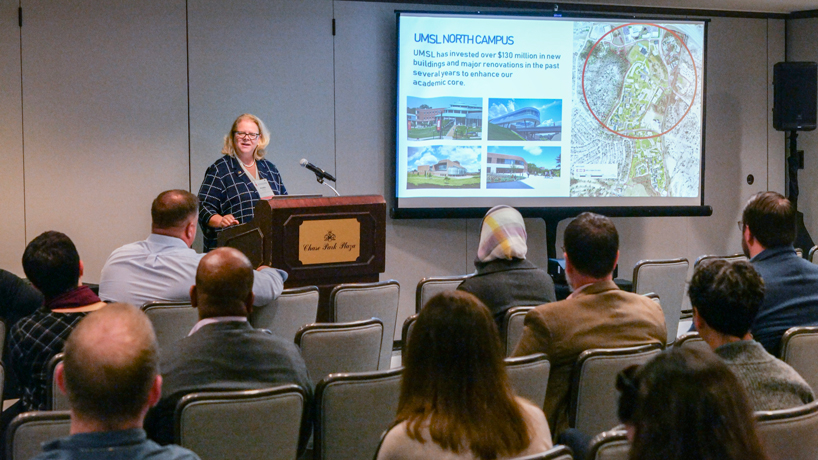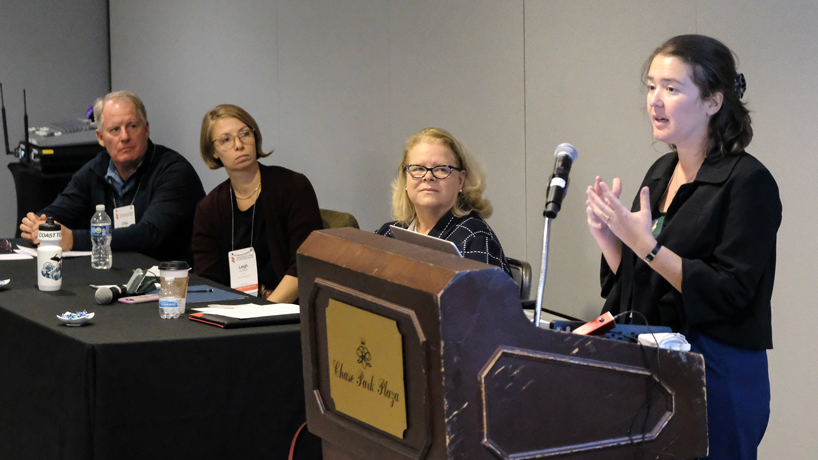
Chancellor Kristin Sobolik speaks at The Society of College and University Planning’s North Central Regional Conference on Wednesday at The Royal Sonesta Chase Park Plaza hotel. Sobolik joined partners from Lamar Johnson Collaborative, Public Design Bureau and Urban Strategies, Inc., in a panel presentation about UMSL’s Campus Master Plan and how it’s being put into action. (Photos by Derik Holtmann)
Demolition and construction crews remain hard at work at the University of Missouri–St. Louis as a physical transformation of the campus continues to take shape.
The university is embarking on $110 million in improvement projects as it moves to consolidate the academic core on North Campus and enhance the student and prospective student experience through, among other things, upgrades to University Libraries and the creation of the Richter Family Welcome and Alumni Center. It will also be moving to demolish several aging buildings on South Campus, freeing up 35 acres of land for the proposed North St. Louis County Business and Workforce District.
Work on the Transform UMSL initiative is scheduled to continue into 2026, but already, it’s being used as a test case for others to learn from the value of planning and how to be ready to take advantage of opportunities to put those plans into action.
Chancellor Kristin Sobolik joined Lamar Johnson Collaborative Managing Director Chip Crawford, Public Design Bureau Principal Engagement Specialist Liz Kramer and Urban Strategies, Inc. Partner Leigh McGrath in a panel presentation Wednesday morning at The Society for College and University Planning’s North Central Regional Conference, held at The Royal Sonesta Chase Park Plaza hotel in the Central West End. They talked about the development of the Campus Master Plan, approved by the University of Missouri Board of Curators in November 2021, which undergirds all the changes underway today.
Lamar Johnson Collaborative Managing Director Chip Crawford, Urban Strategies, Inc. Partner Leigh McGrath and Chancellor Kristin Sobolik listen as Public Design Bureau Principal Engagement Specialist Liz Kramer speaks at The Society of College and University Planning’s North Central Regional Conference.
“Our master plan that we worked on with this group is really intrinsically meaningful and foundational for how our entire campus is moving forward,” Sobolik said as she opened the 50-minute presentation to an audience of more than two dozen college and university planners. “Why we needed a master plan was to really No. 1 pragmatically get a handle on what we as a public higher educational institution could do with 350 square acres, over 40 buildings with a lot of deferred maintenance, and of course, in the midst of a lot of change nationally within higher education. We wanted to make sure that we continue to be educationally relevant for our students and for our city, and that means making sure we are economically managing our assets well, as well as thinking about what we are doing for our communities as an anchor institution.”
UMSL began its planning process by partnering with Lamar Johnson Collaborative, a national architectural design firm with an office in nearby Overland, Missouri, as well as Public Design Bureau and Urban Strategies. Sobolik recalled fondly some of their earliest meetings which they were able to hold in person after the initial rollout of vaccines during the COVID-19 pandemic.
In those early days, Kramer led an iterative process to try to understand the underlying needs and motivations of the campus community. They held virtual workshops for employees, students, alumni and community members that prompted them to dig into ideas about what could be changed. They tried to take steps to ensure they were getting input from people whose voices might not always be heard.
“The alumni, the students at UMSL, the faculty, the staff feel incredibly passionate about UMSL as a campus,” Kramer said. “We heard so much love for this community and its desire to support what it could become.”
McGrath, based in Toronto, described the process of translating the various things they heard from UMSL’s leadership and community members and figuring out how those needs and objectives could be manifested in changes to UMSL’s physical space. That included a technical analysis of features such as transportation, engineering, landscape movements, the condition of buildings, adjacencies and campus consolidation plans that were already in place.
“Collectively, we could start to understand where those opportunities might be to start to implement, or realize in physical way, some of the objectives of the institution,” McGrath said. “Mapping this stuff out helps us see patterns, right? It helps us to see relationships between different uses of buildings and landscapes so that we can help achieve those objectives.”
Crawford expressed how fortunate he’s been to be involved in this undertaking.
“This was an amazing opportunity for us to take a really hard look at a really difficult situation,” he said. “The scale of the campus, the deferred maintenance, all the issues that have been mentioned earlier, were pretty much at a breaking point. I felt like the most exciting thing about all of that is the leadership of this institution knew what was going on and had the absolute courage to make a difference. You don’t find that everywhere.”
Because university leaders were able to take a critical look at the campus needs and help develop a plan to address them in the future, they were also ready to act to take advantage of the rare funding opportunity that came with the passage of the American Rescue Plan Act.
The state of Missouri has so far directed $60 million in federal ARPA funding toward the Transform UMSL initiative. The university is continuing to raise private donations to help realize the vision outlined in the master plan.
Under the direction of Executive Director Matt Prsha, Assistant Director Blake Sutter and the rest of the UMSL Facilities team, the university has already completed the renovation of the second floor of the Patient Care Center. It is nearly finished with demolition of the south part of the J.C. Penney Building to create space for the Richter Family Alumni Center and has begun work on the renovations to the Thomas Jefferson and St. Louis Mercantile Libraries. There is also work underway on the Social Sciences and Business Building as UMSL prepares to relocate the College of Education and the Pierre Laclede Honors College from South Campus to North Campus.
UMSL has continued to pivot when necessary to respond to the realities uncovered during the evaluation and construction process.
Sobolik hopes the land assets that are being created by this initiative can be put to use in public-private partnerships that will benefit the university and the surrounding community and region in the years ahead.
“On March 9, 2020, I would not have envisioned that we would be able to be here at this time, in this exciting transition for our university, for St. Louis as a resurgent city, for our role as an anchor institution,” Sobolik said. “I tell you, it’s an exciting time to be the chancellor at UMSL, and I’m so pleased because I’m telling you, LJC, this isn’t the end. We’re going to have a lot of plans moving forward.”















